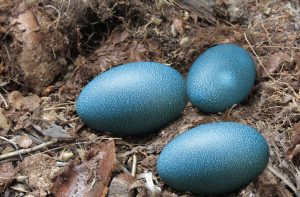What Came First, the Emu or the Egg?
Emus hatch from eggs. Emu eggs are laid by emus. Which came first is a perplexing question that cannot easily be answered. Whichever it was, we are glad that both emus and emu eggs are part of the U.S. agricultural scene.
An emu is a large flightless bird that is native to Australia. They can stand nearly 6 feet tall and weigh over 120 pounds. Emus produce highly nourishing red meat with no fat marbled through the muscles. The fat from the emu can be refined into a moisturizing oil with the same lipid (fat) panel as human skin that nourishes the cells. The emu lays a dark green egg that has an average weight of one and a half pounds. Most emu hens will lay an egg every 3 days during their laying season.
Emu eggs are edible and quite nutritious. The emu egg has a greater quantity of yolk compared with white than the chicken egg, as well as less water overall. The amount of fat (percentage-wise) in an emu egg is, also, greater; 16% lipids in the emu egg vs. 10% lipids in the chicken egg.
However, if you look at the “good” fats vs. the “bad” fats, the emu egg has a lower percentage of bad fats. These nutritious eggs contain 68% unsaturated fat and 8 of the 10 essential amino acids we require, including Lysine. Lysine plays a major role in building muscles, calcium absorption, and the production of hormones, enzymes, and antibodies. With a volume equal to 10 chicken eggs, a single emu egg can make breakfast for a crowd. They are also great for baking, producing moist, fluffy cakes and delectable cookies.
Emu egg can be used as an ingredient in making soaps to add fat soluble vitamins A, D, E and K. Egg yolks provide lecithin, a natural antioxidant and emollient while, the egg whites add rich protein and help to tighten skin.
And, we can’t forget about the egg shells. Once the egg’s contents have been removed, it’s time to focus on the beautiful green eggshell. These large, dark green eggs with layers of dark green, turquoise and white, lend themselves to the creation of beautiful art work. The eggs are first washed and sanitized. Then the eggs can be painted and hung like Christmas ornaments, made into jewelry boxes and music boxes or decorated like the famous Faberge eggs.
Many artist carve emu eggs because of the different color layers. The dark green outer covering varies from hunter green to almost black. The middle color is a teal green to a medium blue, the inside a bright white. The blue is actually as many as 7 subtle layers of color, each about the thickness of a sheet of paper. These different layers of color can be utilized to add texture and depth to artwork and make even a simple design dramatic. The texture, contrast and natural colors of the shell make even a simple design dramatic. Many interesting items, including nightlights, can be made from a lacework cut eggshell.
Pieces of emu egg shell can be used to make inserts for jewelry and the smaller broken pieces can be used to make mosaic artwork. Artists should check out the Midwest “EGGS’travaganza” emu egg art contest website at www.AEAEggArtContest.com.
While emu egg shells can be found throughout the year, edible emu eggs are seasonal items that are only available from October through April, at select groceries and through your local emu farmer.

Founded in 1989, The American Emu Association is a non-profit trade association representing breeders, producers and marketers of emu meat, oil and other emu co-products. The emu industry is an alternative agricultural industry, dominated by the small farmer, who is devoted to humane and environmentally positive practices that will produce beneficial products for society. For more information about the American Emu Association (AEA) or the emu industry visit https://aea-emu.org
